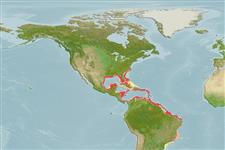Arcinella arcinella (Linnaeus, 1767)
Spiny jewelbox| Native range | All suitable habitat | Point map | Year 2050 |

|
| This map was computer-generated and has not yet been reviewed. |
| Arcinella arcinella AquaMaps Data sources: GBIF OBIS |
Google image | No image available for this species;
drawing shows typical species in Chamidae.
Classification / Names Populärnamn | synonymer | CoL | ITIS | WoRMS
Bivalvia | Venerida | Chamidae
Environment: milieu / climate zone / djupintervall / distribution range Ekologi
; djupintervall 2 - 73 m (Ref. 83435). Tropical
Distribution Länder | FAO områden | Ekosystem | Förekomster | Utplanteringar
Western Atlantic: Caribbean Sea, from Florida to Brazil.
Length at first maturity / Size / Weight / Age
Könsmognad: Lm ? range ? - ? cm Max length : 5.3 cm DL hane/ej könsbestämd; (Ref. 83435); common length : 5.1 cm SHL hane/ej könsbestämd; (Ref. 360)
Short description Morfologi
Life cycle and mating behavior Könsmognad | Reproduktion | Lek | Eggs | Fecundity | Larvae
Main reference
referenser | Koordinator | Medarbetare
Sabelli, B. and H.S. Feinberg (eds.) 1879 Simon and Schuster's Guide to Shells. Simon and Schuster's Inc. New York. 512 pp. (Ref. 360)
IUCN Red List Status
(Ref. 130435: Version 2025-1)
CITES status (Ref. 108899)
CMS (Ref. 116361)
Threat to humans
Human uses
| FishSource |
Verktyg
Ytterligare information
Födosammansättning
Födointag
Predatorer
Max. ages / sizes
Length-weight rel.
Length-length rel.
Length-frequencies
Mass conversion
Abundans
Internet-källor
BHL | BOLD Systems | CISTI | DiscoverLife | FAO(Publication : search) | Fishipedia | GenBank (genome, nucleotide) | GloBI | Gomexsi | Google Books | Google Scholar | Google | PubMed | Tree of Life | Wikipedia (Go, sök) | Zoological Record



